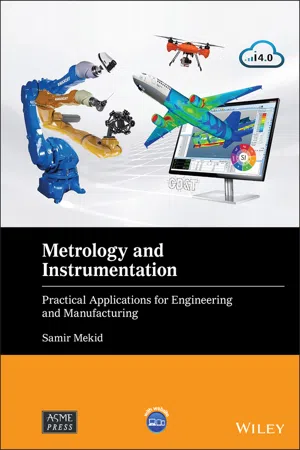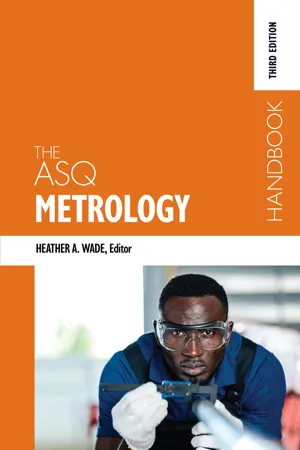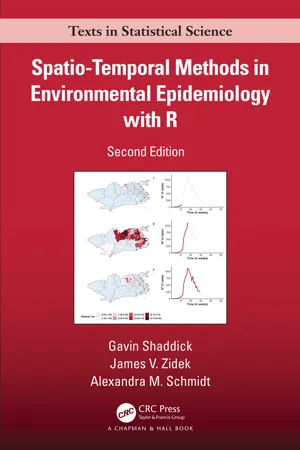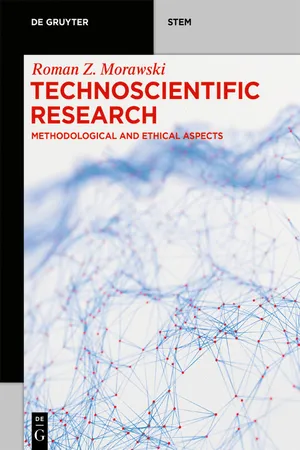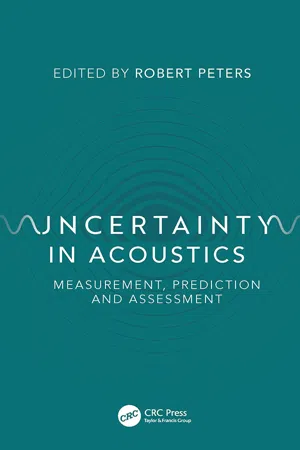Physics
Uncertainties and Evaluations
In physics, uncertainties refer to the potential errors or variations in measurements or calculations. Evaluations involve assessing and quantifying these uncertainties to determine the reliability and accuracy of the results. Understanding and accounting for uncertainties is crucial in physics to ensure the validity of experimental data and the precision of theoretical predictions.
Written by Perlego with AI-assistance
Related key terms
6 Key excerpts on "Uncertainties and Evaluations"
- eBook - ePub
Metrology and Instrumentation
Practical Applications for Engineering and Manufacturing
- Samir Mekid(Author)
- 2021(Publication Date)
- Wiley-ASME Press Series(Publisher)
8 Uncertainty in Measurements“As far as the laws of mathematics refer to reality, they are not certain; and as far as they are certain, they do not refer to reality.”—Albert Einstein8.1 Introduction and Background
As it has been introduced in previous chapters, measurement is accompanied necessarily by an error of measurement due to various reasons including the instrument, the method of measurement, environmental conditions, and many more. The unreliability surrounding this measurement is the uncertainty of measurement. The background and fundamental definition of uncertainty and error will be discussed later based on international standards with all aspects in general practice.The ISO 15189:2012 standard describes some enhanced expectations on the measurement of uncertainty and the ISO 17025 standard specifies requirements when reporting and evaluating uncertainty of measurement.15189:2012 & 17025:2017 Requirements
ISO 15189: 2012 Section 5.5.1.4: “The laboratory shall determine measurement uncertainty for each measurement procedure, in the examination phases used to report measured quantity values on patients' samples. The laboratory shall define the performance requirements for the measurement uncertainty of each measurement procedure and regularly review estimates of measurement uncertainty.”Section 5.6.2: “Upon request, the laboratory should make its estimate of measurement of uncertainty available to laboratory users”.17025: 2017 Section 7.6.1: “Laboratories shall identify the contributions to measurement uncertainty. When evaluating measurement uncertainty, all contributions that are of significance, including those arising from sampling, shall be taken into account using appropriate methods of analysis.”Section 7.6.3 - eBook - ePub
- Heather A. Wade, Heather A. Wade(Authors)
- 2023(Publication Date)
- ASQ Quality Press(Publisher)
23Once measurement uncertainty is calculated, it must be evaluated. Measurement uncertainty is not static. For a given measurement or set of measurements, the measurement uncertainty is associated with a stated quantity value attributed to the measurand. When this value is changed, the associated measurement uncertainty also changes.24EVALUATING MEASUREMENT UNCERTAINTY
When one makes any measurement, there is a measurement uncertainty associated with it. In an ideal world, the measurement that one makes would be absolute and have a true value associated with it; we would not have to worry about it because no measurement error would be present. This is described as the “one measurement bliss or one measurement quandary depending on whether one is an optimist or a pessimist.”25 Unfortunately, we do not live in an ideal world, and no measurement is perfect. These imperfections give rise to an error in the measurement result. An error has two components: random and systematic.26 In this chapter we discuss what these components are and how to quantify them. Granted, there are situations in which one measurement is all that it is possible to make, even though multiple factors contribute to the uncertainty of measurement. That is why one should always consider estimating the uncertainty of measurement.This section describes the process of estimating measurement uncertainty in a test and calibration environment. Practical examples using various parameters are used to illustrate the process of determining estimated measurement uncertainty. - Gavin Shaddick, James V. Zidek, Alexandra M. Schmidt(Authors)
- 2023(Publication Date)
- Chapman and Hall/CRC(Publisher)
Chapter 3 The importance of uncertainty: assessment and quantificationDOI: 10.1201/9781003352655-33.1 Overview
Uncertainty is a topic that permeates all scientific inquiry and its importance is magnified when the results are applied in decision-making, which in this setting will involve legislation, regulations and designing public policy.Despite the general importance of the concept of ‘uncertainty’, its meaning lacks a universally agreed on definition. In fact, it shares its general lack of definition with ‘information’, as described by the late Debabrata Basu (Basu, 1975 ):‘But what is information? No other concept in statistics is more elusive in its meaning and less amenable to a generally agreed definition’.It has been described in various ways, including ‘incomplete knowledge in relation to a specified objective’ which arises ‘due to a lack of knowledge regarding an unknown quantity’ (Bernardo and Smith, 2009 ). However, the lack of a clear-cut definition has not stopped people from taxonomizing it! Thus, we have for example the distinction between aleatory (stochastic) and epistemic (subjective) uncertainty (Helton, 1997 ). It seems generally agreed that some aspects of uncertainty are quantifiable while others are inherently qualitative, that is, not subject to quantification. The latter would, for example, include framing the problem to be investigated by defining the system boundaries and explicating the role of values (van der Sluijs et al., 2005 ). Both qualitative and quantitative aspects of uncertainty need to be taken into account within environmental risk analyzes.There will often be intangible sources of uncertainty which will arise through the subjective judgements that are sometimes required to estimate the nature and magnitude of empirical quantities where other methods are not appropriate. Uncertainty may arise as a result of imprecise language in describing the quantity of interest and disagreement about interpretation of available evidence. There may also be uncertainty about the actual methods being used to assess policy changes, whether the data available to implement them is suitable for the purpose and the extent to which the results can be generalized.- No longer available |Learn more
Technoscientific Research
Methodological and Ethical Aspects
- Roman Z. Morawski(Author)
- 2019(Publication Date)
- De Gruyter(Publisher)
The purview of this study includes the conditions under which measurement produces knowledge; the content, scope, justification and limits of such knowledge; the reasons why particular methodologies of measurement and standardisation succeed or fail in supporting particular knowledge claims and the relationships between measurement and other knowledge-producing activities such as experimentation, modelling and theory building 403. From practical point of view, the methods for evaluation of uncertainty are of key importance and, therefore, will be covered here in more detail. As already mentioned in Chapter 6, measurement uncertainty is defined by the VIM as a “non-negative parameter characterising the dispersion of the quantity values being attributed to a measurand, based on the information used” 404. The recommended methods for estimation of that parameter have been internationally and transdisciplinary agreed and specified in the GUM 405. As stated there, an ideal method for evaluating and expressing the uncertainty of the result of a measurement should be universal, i.e., it should be applicable to all kinds of measurements and to all types of input data used in measurements - eBook - ePub
Metrology in Industry
The Key for Quality
- Dominique Placko, Dominique Placko(Authors)
- 2013(Publication Date)
- Wiley-ISTE(Publisher)
7.2. Measurement of physical quantityMeasuring amounts to attributing a numeric value to an observed property by directly or indirectly comparing it to a standard. A physical quantity is an observable property specific to an object, a system or a physical state. The mass of a body is characteristic of its inertia; pressure and temperature are characteristic of the thermodynamic state of a gas.Three inextricably connected elements are included in the expression of a physical quantity: – a numerical value; – a unit; – an uncertainty. The quantity to be measured is called the measurand. The systems of observation and comparison and the standard make up the measurement system. Note: the words “error” and “uncertainty” which stand for two different concepts must be carefully distinguished; they must not be confused or interchangeably used. Uncertainty: a new concept introducedThe concept of uncertainty is comparatively new in the history of measurement. For decades it was error that was calculated, but the fundamental difference between the concepts of error and uncertainty must be clearly defined.It is now admitted that once all the known or suspected components of the error have been assessed and the adequate corrections have been made, there still remains an uncertainty about the value of the stated result (the correction is done as accurately as possible, but it is never perfect).Figure 7.1. Presentation of the concept of uncertaintyThe metrologist’s aim is to get a result close to the right value. In order to reach this goal, he will reduce systematic errors by applying corrections and random errors by repeating his measuring process.This new approach was initiated in 1980 by a working party formed within the context of the International Bureau of Weights and Measurements (BIPM). It has resulted in the publication of an ISO guide in 1993 entitled “Guide for the expression of measurement uncertainty”, also known under its acronym, “GUM”. This chapter is based on the concepts and notations written in the 1993 ISO guide. The GUM is referred to in numerous national norms. - eBook - ePub
Uncertainty in Acoustics
Measurement, Prediction and Assessment
- Robert Peters, Robert Peters(Authors)
- 2020(Publication Date)
- CRC Press(Publisher)
Chapter 2Uncertainty in Acoustic Measurements
Robert PetersIntroduction
Inevitably, repeated measurements of any specific sound level, reverberation time or vibration level will yield a range of results, indicating a degree of uncertainty or doubt about the measured value. This chapter aims to introduce the basic ideas and concepts relating to uncertainty. It repeats some of the general ideas in Chapter 1 but offers specific examples of uncertainty in acoustic measurements, including how to minimise and evaluate such uncertainties. Ideas and concepts relating to uncertainty are explored in more detail in the following chapters, each dealing with a different aspect of uncertainty in acoustic measurement, prediction and assessment.Two of the references listed at the end of this chapter, the International Organization for Standardization’s (ISO) Guide to the Expression of Uncertainty in Measurement (GUM 1995) and the United Kingdom Accreditation Service’s Expression of Uncertainty and Confidence in Measurement (UKAS 2012 ), explain in detail the statistical evaluation of measurement uncertainty leading to an expanded uncertainty, stated to a certain confidence level (usually 95%), as explained in Chapter 1 . The third reference, the short book by Stephanie Bell (2001) of the National Physical Laboratory (NPL), in addition to being easier to read, provides a gentler introduction and simplified versions of much of what is in the first two references. Only the fourth reference relates specifically to acoustics and sound levels. It is by Geoff Craven and Nicholas Kerry of University of Salford (2007) and relates specifically to uncertainty in the measurement of environmental noise. All four references are recommended to the reader, but the last two should receive particular attention.In some cases, the uncertainty is determined not by tests of repeatability but by the resolution of the measuring instrument, that is, by the smallest scale interval available to the observer. A simple example would be measurement of the length of a pencil using a ruler graduated in centimetre divisions, which might produce a result such as 11.5 ± 0.5 cm. Another example might be measurement of a very steady sound level from a loudspeaker using an old analogue sound level meter calibrated in 1-dB steps – an example is given in the Craven and Kerry (2007)
Index pages curate the most relevant extracts from our library of academic textbooks. They’ve been created using an in-house natural language model (NLM), each adding context and meaning to key research topics.
